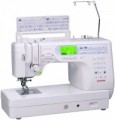Number of stitches
The number of stitches that a sewing machine can sew. The larger this number, the more extensive the capabilities of this model, the wider the choice the user has; however, it wouldn’t hurt to clarify the specific range of supported stitches separately.
The fewest options - mostly up to 25 - are provided in electromechanical machines, as well as specialized devices such as overlockers and carpet lockers (see “Type”). In computer-controlled devices, the number of lines can be in the dozens, and some also allow you to download additional options from the computer.
Number of loops
The number of welt stitches that a sewing machine can make. Different types of loops are used for different types of fabrics and clothing. The larger this number, the wider the choice the user has and the less likely it is that the machine’s arsenal will not have the required type of loop.
Presser foots
Types of feet supplied with the sewing machine.
— Universal. A foot used for standard sewing, mainly straight stitches and zigzags.
—
Overlock foot. A foot designed for overlocking. By definition, it is found in devices with an overlock function (see “Type”), however, it can also be provided in traditional sewing machines. In the latter case, such a foot, of course, will not replace a full-fledged overlock, but in some situations it allows you to do without it.
—
Upper fabric conveyor. An additional top-mounted feed dog in place of the stock foot, in addition to the standard bottom feed dog. Such a device makes it easier to work with thin, delicate and sliding fabrics, as well as sewing together several layers of fabric: the material moves as evenly as possible, without distortions and displacements.
—
Foot for sewing in a zipper. The foot for sewing in a zipper can have a different size and design — in particular, there are special devices for sewing in a hidden zipper. The specific features of this device should be clarified separately.
—
Foot for decorative stitching. Feet designed for various types of decorative stitching. Such a line may not have a functional role, its main task is to emphasize a certain element of clothing (edges, pockets, individual seams, etc.). Anyway, the stitch line sh
...ould usually strictly follow the contour along which it is applied — and this contour can consist of both straight lines and curved lines. Special foots for decorative stitching simplify the task: they are equipped with rulers or other devices that allow you to control the parallelism of the stitches.
— Satin stitch foot. This foot will be suitable for appliqué and other work where zigzag stitches are often used.
— Blind stitch foot. Foot designed for blind seams used when hemming the edge of the fabric. It is equipped with a device that provides a hem of the fabric and in this position feeds it under the needle.
— Quilting foot. Special feet for quilting — patchwork. In such works, it is necessary to sew the fabric in several layers, as well as to perform figured seams. In extreme cases, you can use the usual universal foot for quilting, but using a special device is still much more convenient.
— Monogramming foot. The foot for embroidery of monograms will allow you to make embroidery on any object, thereby "decorating" it with your signature or the emblem of any institution, company, sports club.
— Buttonhole foot. Buttonhole foot. It eliminates the need for manual work. The sewing machine will do everything for you, which will reduce your time and please you with quality.
— Foot for sewing on buttons. A foot designed to hold the button on the fabric while sewing on. It has a special protrusion pointing down: when the main part of the foot is pressed against the button, this protrusion presses the fabric and prevents it from slipping.
In addition to the above, other types of feet may be included in the delivery package — for example, for satin stitching, for processing sections, etc.Sewing advisor
Built-in help system that displays various tips on the display. Some sewing advisers are capable of providing very detailed information, step-by-step instructions with pictures and control of settings (if the settings are incorrectly set, the device issues a warning). This feature is especially useful when learning to sew for the first time, but it can also be useful for an experienced sewer who is faced with an unusual task.
Ruler on body
The ruler scale applied directly to the body of the sewing machine. This feature allows you to simplify and speed up some measurements in the process of work: attaching the measured segment to the body of the machine is often more convenient than looking for a ruler or centimetre tape.
Cover
The type of cover supplied with the sewing machine.
-
Soft. A soft fabric cover protects the machine mainly from dust and dirt and provides almost no protection from bumps and collisions. At the same time, having removed such a cover for the duration of work, it can be folded compactly.
-
Hard. A cover in the form of a hard cover put on from above or a case in which the machine fits. Such a cover is rather bulky, it cannot be folded like a soft one; on the other hand, it protects the machine well both from dirt and from collisions and contact with solid objects.

